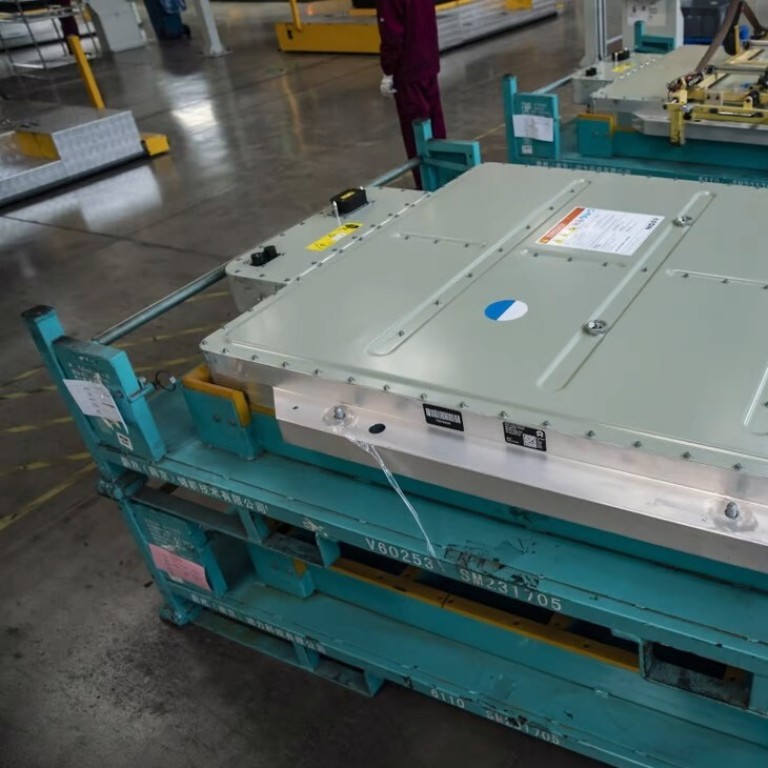
Urgent need for EV battery industry to expand and be more sustainable to meet future demand, analysts say
- Rapid electrification of the transport sector, which accounts for around 25 per cent of global greenhouse gas emissions, means battery production needs to expand
- Ramp-up also poses challenges, such as raw material availability, more sustainable battery production methods and greater innovation
A surge in electric vehicle (EV) sales to meet net-zero climate targets requires an immediate scale-up of EV battery production and relevant infrastructure, adding to pressure on governments and industry leaders to get on top of raw material, innovation and sustainability challenges, analysts say.
The global stock of electric cars increased by over 40 per cent year-on-year in 2020, hitting 10 million units, against a decline of more than 15 per cent for the overall car market in the aftermath of the pandemic, said the International Energy Agency (IEA) at an event during COP26 in Glasgow last week, using data from its 2021 outlook.
In the first three-quarters of this year, the global EV market has recorded a nearly 50 per cent year-on-year increase in sales compared to the same period a year ago, according to IEA, leading the agency to set EVs as one of only two technologies out of the 46 it assesses as being on track towards net zero emissions by 2050.
The rapid electrification of the transport sector, which accounts for around 25 per cent of global greenhouse gas emissions, means there is a need for an immediate expansion of battery manufacturing and related supply chains, says the IEA. It said that for the world to have a pathway to net-zero emissions by 2050, over 6.5 terawatt-hours (TWh) of battery production capacity will be needed by 2030.
Tesla success at China import expo may push it to expand Shanghai production
“Think of that in terms of the number of giga-factories that need to be installed every year from now to 2030 – we‘re talking about 20 giga factories each year,” said Leonardo Paoli, an energy analyst at IEA, basing the battery demand off the massive battery factories initiated by Elon Musk’s Tesla.

In addition to the need for a rapid scale up of battery production, there are other challenges such as raw material availability, sustainable battery production, innovation on battery chemistry and design, and recycling issues, according to the IEA.
Batteries with higher energy density are needed to enable the electrification of the heavy duty sector as well as other long distance sectors. The cost of EV batteries also needs to fall further if electrification goals are to be achieved on a global basis, said the IEA.
Demand for the raw materials used in the EV industry is also set to soar. “When we look at specific metals, such as lithium, nickel, or even graphite, we‘re talking about increases that are nearly a hundredfold given the net zero emission pathway,” said the IEA’s Paoli.
The world’s supply of lithium is heading for a “serious supply deficit” by 2027, which could hamper the production of an estimated 3.3 million NEVs that year, according to a forecast by energy research firm Rystad Energy.
Xpeng overcomes chip shortages to zoom past 10,000 EV sales in October
Ilka von Dalwigk, policy manager at the European Battery Alliance, expects the gap between EV demand and battery materials to be more severe in coming years.
“We can compare the EV revolution we are experiencing right now with a tsunami,” said Dalwigk, explaining that the wave is building but the effects have not yet been felt. “We’ll experience deficits in a lot of materials in a couple of years,” she added.
Sustainability is another issue.
Production of EV batteries still emits carbon dioxide, mostly from mineral extraction, refining of raw materials, and the manufacturing of battery cells. This will become one of the major sources of emissions in Europe in a few years, said Frederic Hauge, president and founder of Norway-based environmental NGO Bellona Foundation, at the same event during COP26 in Glasgow.
Hauge, together with BEBA, a battery company under Bellona, is planning to build the world’s first carbon-negative battery factory by 2025 by combining solar power with bio-CCS (bioenergy with carbon capture and storage) technologies to give negative carbon accounting for the production Lithium-Manganese-Nickel-Oxide (LNMO) batteries.
The Li-ion batteries that power electric vehicles from Tesla, VW and BYD
Battery makers are also developing new types of batteries made from cheaper and more abundant raw materials. Contemporary Amperex Technology (CATL), a supplier to Tesla and other major EV makers, unveiled the world’s first sodium-ion battery in July hoping to cut reliance on expensive metals, such as cobalt and nickel.
One of the world’s top six EV battery firms, South Korea-based LG Energy Solutions is also working on building a closed-loop that can cover its entire value chain for batteries – from raw material extraction, production and consumption to disposal – that can mitigate the environmental impact of EV batteries.
However, global collaboration is crucial to achieving a more sustainable EV battery industry. “What we see today is a lot of the supply chains going toward Asia. It‘s not only because the raw materials are concentrated there, but the processing technologies are there,” said Dalwigk.
How do EV batteries work, and why do they sometimes catch fire?
The world’s reserves of lithium stood at 21 million tonnes in 2020, of which 44 per cent was in Chile and 22 per cent in Australia, according to the US Geological Survey. Australia, meanwhile, accounted for nearly half of the production, while China – the world’s largest NEV market – imported some 80 per cent of the industry’s needs.
“I think in future, these supply chains will hopefully be more diversified and more vertically integrated,” said Dalwigk. “So we will see a completely different pattern that... makes supply chains more stable and reliable.”

